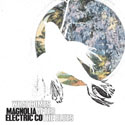
Magnolia Electric Co.
What Comes After the Blues
Secretly Canadian
A friend of mine recently had a discussion with an acquaintance of hers about the relevancy of Jason Molina since his transition from Songs: Ohia to Magnolia Electric Co. This person dismissed Molina’s recent Americana leanings as second-rate, when compared to Songs: Ohia’s more metal-heavy catalogue. My friend took the opposing view, and she is, of course, correct. Molina’s implied mission statement throughout his career has been to find the best way to cope with life while roving through the American mid-west. As with any artist with longevity, in order to avoid stagnation, he’s had to constantly move forward while staying true to his muse – in Molina’s case, the long dark highway. These days, his path is leading him through territory that’s been trod by modern bluegrass revivalists Jim & Jennie and The Pinetops, the ’70s ghosts of Bob Seger and Neil Young, and even CCR.
What Comes After the Blues cracks like thunder on its opening track, “The Dark Don’t Hide It.” A downpour of steel guitar acts as the perfect foil for the rock riff maelstrom and Molina’s fiery sermon. Surprisingly, the level of gravelly pitch on this song isn’t reached again on the album’s remaining seven tracks. The closest is the Jennie Bradford-penned “The Night Shift Lullaby,” but the raging fires are still dimmed to slow-burning embers by this point. The rest of the disc is populated by acoustic numbers, sometimes stark and always somber. On the parting duo of “Hammer Down” and “I Can Not Have Seen The Light,” Molina takes more of the solo spotlight than he has in most of his previous work – except for his Pyramid Electric Co. turn. The songs feature a single guitar and Molina’s voice, occasionally supported by Bradford on backing vocals. After albums of working with musicians from all over the world, he finally feels comfortable to stand (nearly) on his own and declare that “no one has to be all right, all of the time.”
What Comes After the Blues is ultimately the most satisfying of Molina’s recent work. Not only is it a concise, focused statement, but it’s a hell of a rewarding listen. Even if his time down this particular stretch of road is fleeting, and he ends up back in more familiar Ohia territory, true fans of Molina’s long and winding journey will enjoy the time they spend here and not simply pine for the old days.
Secretly Canadian: http://www.secretlycanadian.com












